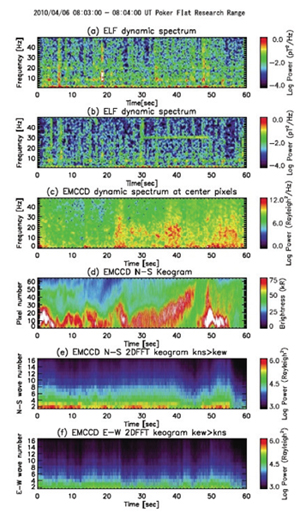Resources
 Part of the Oxford Instruments Group
Part of the Oxford Instruments Group
Expand
Collapse
 Part of the Oxford Instruments Group
Part of the Oxford Instruments Group

Figure 1: This figure shows an example of a high-frequency auroral event. From top to bottom, (a) the dynamic spectrum of north-south component, (b) east-west component of ELF magnetic field data, (c) dynamic spectrum of electron multiplying CCD image data averaged at the center 16 pixels, (d) electron multiplying CCD keogram of north-south direction, and (e) 2DFFT dynamic spectrum of north-south and (f) east-west directions.
Image reproduced by permission of the American Geophysical Union from Ayumi Yaegashi et al, Spatial-temporal characteristics of flickering aurora as seen by highspeed EMCCD imaging observations, Vol. 116, A00K04.
The beautiful light displays known as aurora occur when energetic charged particles collide with atoms in the high-altitude regions of the atmosphere. One type of aurora, known as flickering aurora, rapidly fluctuates in a manner similar to the reaction of a candle’s flame to a sudden draft of air.
Researchers from Tohoku University in Japan used an Andor iXon electron multiplying CCD (EMCCD) astronomy camera to learn more about flickering aurora. This type of aurora occurs only near the time of the auroral breakup, which is when the arcs of light rapidly grow brighter and twist into contorted shapes that sweep across the sky.
Scientists believe that the generation of flickering aurora is related to auroral particle acceleration and wave-particle interactions that occur in the region where the Earth’s magnetosphere and ionosphere meet. The magnetosphere is formed by the Earth’s magnetic field interacting with and deflecting charged particles coming from the sun, and the ionosphere is the upper part of the Earth’s atmosphere that is ionized by solar radiation.
The researchers sought to better characterize the spatiotemporal characteristics of flickering aurora. “Field-aligned acceleration processes existing in the altitude range of several thousands of kilometers play a crucial role in the generation of auroras,” said Takeshi Sakanoi, who was part of the research team. “Understanding these processes is one of the most important issues in our research field - magnetosphere-ionosphere physics - as well as in fundamental plasma physics which is used in, for example, plasma fusion.”
However, flickering aurora are difficult to study because of how fast they modulate and because of their weak intensity. Thus the researchers, led by Shoichi Okano, turned to an iXon EMCCD astronomy camera from Andor Technology to allow them to observe the flickering aurora. "The Andor camera was important to our experiment because the iXon's electron multiplication and binning abilities allowed us to operate at an effective speed and derive spatial information. The camera features allowed us to discover new, previously unobserved types of flickering aurora " Sakanoi said.
The researchers made observations at the Toolik Field Station and the Poker Flat Research Range in Alaska during the winter. They used the iXon EMCCD astronomy camera with a 50 mm F1.2 lens and a 670 nm filter to measure allowed transition emissions from N2 1st positive band, operating at 100 Hz sampling rate. The field of view was 9.3° X 9.3°, which is about 16 X 16 km at 100 km altitude. They operated the EMCCD with a 64 X 64 pixel mode (8 X 8 binning for the entire 512 X 512 pixels).
With the EMCCD, the researchers were able to acquire images of some new types of flickering aurora. They observed high-frequency events (greater than ~15 Hz, see figure), low-frequency events (less than ~15 Hz) with rotating features, and flickering stripes. They found that many of the flickering aurora events were in the high-frequency range.
"With the advanced electron multiplying CCD technology, we could acquire auroral images with high temporal resolutions,” Sakanoi said. "As a result, we found flickering auroral variation in a very high frequency range. This characteristics must closely related to the acceleration process and should be helpful to understand it."
